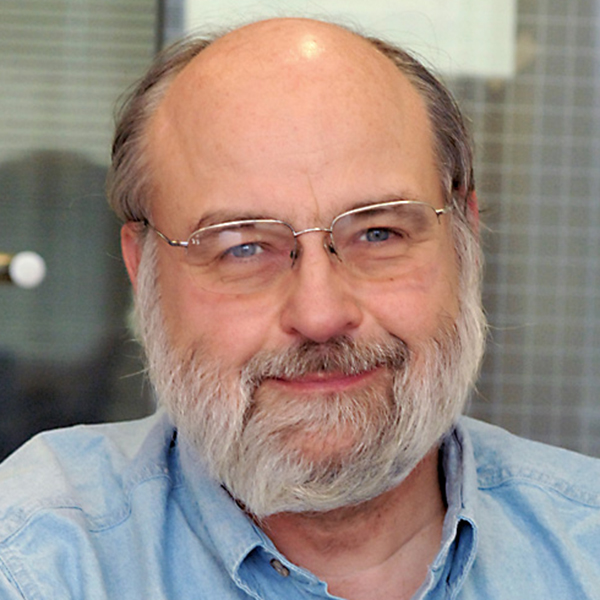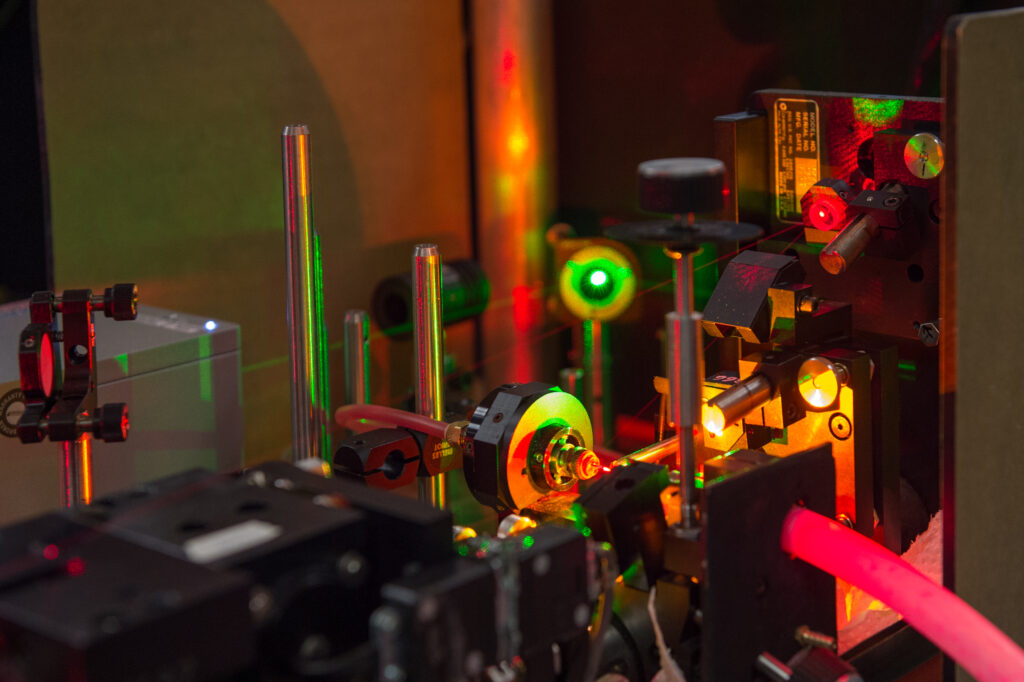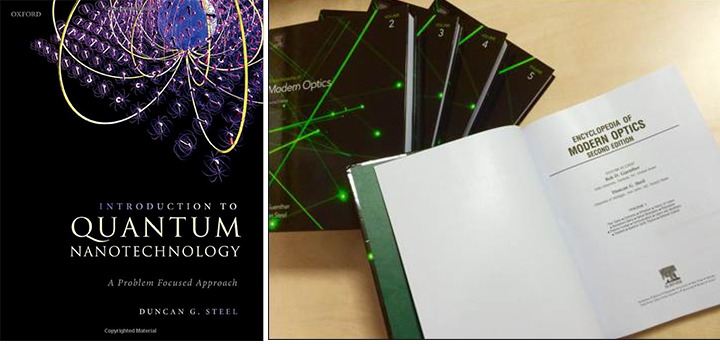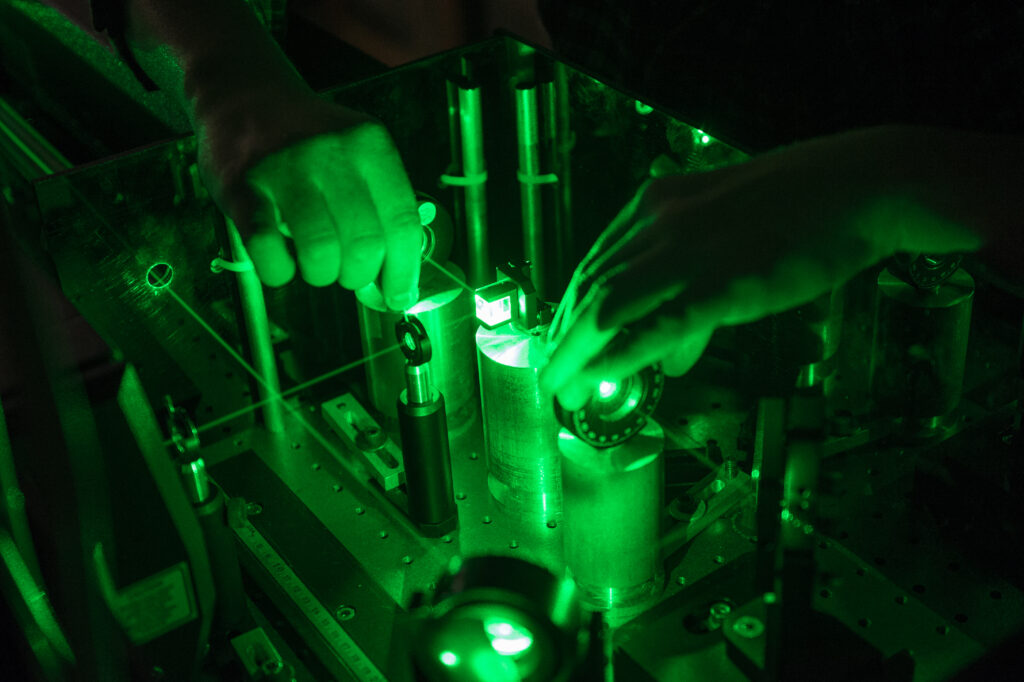Duncan Steel retires, leaving a quantumly inspired legacy

Duncan Steel, the Robert J. Hiller Professor of Engineering, has retired, effective May 31, 2023, leaving a legacy felt across several disciplines and deep in the hearts of many individuals.
Professor Steel was a pioneer in the field of coherent nonlinear laser spectroscopy and a leader in the quantum electronics community. Through his groundbreaking application of laser spectroscopy to quantum processes, he made significant contributions to the emerging field of quantum computing. He also did some very interesting research in the medical school. Along the way, he helped train 62 doctoral students and hundreds of additional undergraduate and graduate students who are carrying his lessons forward to the next generation.
Duncan didn’t just develop scientists. He developed a family of scientists. And that continues on to this day.
Prof. Alex Burgers
Steel’s history at Michigan began as a master’s student in electrical engineering back in 1972, the same year he graduated from The University of North Carolina at Chapel Hill with a degree in physics. After receiving his master’s degree in 1973, he followed that up with a master’s degree in nuclear engineering in 1975, and then, as a doctoral student, continued to take classes wherever he could find something interesting.
“At that point,” said Steel, “I had become an interdepartmental PhD student, which I liked because it didn’t have any requirements.”
His doctoral work centered on spectroscopy, and learning the early quantum theory of the laser. His advisor, David Bach, got him involved in building the first Z-pinch machine on North Campus.
These were the early days of work on atomic energy – and Michigan was one of the world leaders in this area. The Phoenix Memorial Laboratory was up and running, along with the Ford Nuclear Reactor. Doctors at U-M Medical Center also used the facility for cancer detection research.
Steel recalls visiting the open swimming pool where the nuclear reactor resided. “I’d take a break from my work and I’d wander over there, look down at the operator. We’d wave at each other,” he says with his gleeful laugh. “It wasn’t like that later.”
The work he was taking a break from was going on in Bach’s lab, with that Z-pinch machine. He was saving the images produced by the laser beam’s burn spot, but as they morphed from the expected donut shape to something different, he set them aside, a bit perplexed.
When Bach visited the lab and saw these images, Steel recalls him saying, “I think you just got your thesis. And he walked out the door and closed it. I started looking at the pictures, and I saw what had excited him.”
There was no theory at the time to explain the new structured pattern.
“I later realized that we’d been possibly the first ones to see what was then called self-focusing in plasmas,” said Steel. And his career was off and running.
Even before officially receiving his interdisciplinary doctoral degree in Electrical Engineering and Nuclear Engineering in 1976, Steel began his decade-long career at Hughes Research Laboratories.
“I think they brought me on board because I knew how to build lasers,” said Steel, “and I knew a lot about electronics, and I could do things that you couldn’t buy.”
Once again, Steel was working on cutting-edge theory as he investigated optical phase conjugation, a non-linear optical process. One practical use for the technique was to improve a satellite’s communication with the ground station even amidst intense air turbulence.
“Suddenly quantum mechanics was front and center in terms of how things were working at the electronic level, and I was learning all this stuff that was just fantastic,” he recalled.
Steel Returns to Michigan
Just as Steel was feeling an urge to go beyond the confines of his research at Hughes, Jim Duderstadt began to recruit Steel back to Michigan. Duderstadt, a professor of Nuclear Engineering, was a co-thesis advisor and by then Dean of the College of Engineering (just a few years later he was named President of U-M).
“I thought it was a really dumb idea at the time,” recalled Steel with a chuckle. But, trusting in Duderstadt, he returned in 1985 as an Associate Professor of Electrical Engineering and Computer Science. After a while, he realized “I had come home to what I really wanted to do. I began to realize the impact I could have on students.”
His 62 doctoral students (25% were women), received degrees in physics, electrical engineering, applied physics, biophysics, and biochemistry. And he was on the thesis committee of 128 additional students from an even wider range of disciplines.
This diversity in degrees reflected Steel’s relentless curiosity, which led to his joint appointments in the departments of EECS, Physics, Biophysics, the Applied Physics program, and the Institute of Gerontology. He served as the Director of the Biophysics Enhanced Program between 2007-2009.
His appointment in Gerontology (the study of aging) was established immediately upon his return to Michigan, and allowed Steel to keep his foot firmly planted in the medical field. One little-known fact about Steel is he was a full-time medical student at UCLA while he was still working at Hughes. He had an intense interest in the life sciences.
To pursue his interest in how engineering tools could advance health, Steel reached out to Ari Gafni, a professor of Biological Chemistry, who was looking at the biophysics of age-related protein folding diseases, like Alzheimer’s and Parkinson’s Disease.
He asked Gafni, “Hey, what about thinking about these things a little differently, and using some more powerful laser tools?”

That collaboration lasted nearly two decades, and contributed to the training of quite a few students, including Dr. Robin Johnson Cook, who specializes in Child Neurology, Epileptology and Pediatrics at Helen Devos Children’s Hospital, and Vinod Subramaniam (PHD Applied Physics 1996), who is the President of the University of Twente.
Steel’s involvement with the Medical School was almost a secret passion. His more visible contributions were seen on the engineering side of campus.
For example, Steel was invited to be a leader in creating a center of optics within engineering by both Duderstadt and Chuck Vest (who succeeded Duderstadt as Dean of the College of Engineering in 1986) before he even arrived at Michigan.
Emmet Leith (well-known inventor of practical holography) was here at that time, but there wasn’t much else going on in the field of optics. Physics luminaries like Peter Franken (who led the first demonstration of second-harmonic generation) had left Michigan and Gabriel Weinreich had moved on to a different area of focus.
Within three years of arriving, Steel had helped recruit future Nobel Prize winner Gérard Mourou to Michigan in 1988, and the rest – as they say – is history. Steel served as the first director of the Optical Science Lab (now known as Optics and Photonics Lab) between 1988 and 2007.

Steel’s own research was focused on the development and application of various laser-matter interaction studies and quantum optics in fields including plasmas, optical phase conjugation, atomic and molecular spectroscopy, condensed matter physics, protein folding and – most recently – quantum computing, where he has made several groundbreaking contributions to quantum processes.
For example, in 1998, Steel and his collaborators were the first to demonstrate coherent optical control of a single quantum dot. This work led to the idea that quantum dots could be used to build quantum computers (a quantum dot acts like a transistor in a conventional computer). In 2003, he demonstrated the first controlled NOT-gate in a semiconductor, achieved by all optical control in a semiconductor quantum dot without the need for attaching wires. This demonstrated the potential for coherent, optically driven quantum computing in scalable architectures. And in 2013, Steel and colleagues proved the mysterious phenomenon known as quantum entanglement, while also proving that the process is scalable.
My research results were exciting for a time, then they were history. But it is the students who go on for decades.
Duncan Steel
His pioneering research led to his being named the Robert J. Hiller Professor of Engineering in 2005, and earned him the Isakson Prize from the American Physics Society in 2010 “For seminal contributions to nonlinear optical spectroscopy and coherent control of semiconductor heterostructures.” He received a Guggenheim Award in 1999, and was a Fellow of APS, OSA, and IEEE.
Looking back, Steel says, “The frontier is constantly moving forward. My research results were exciting for a time, then they were history. But it is the students who go on for decades.”
Empowering and Inspiring Students
The 62 students who worked closely with Steel on their dissertations tell only part of the story of his impact on students. There were also the courses he developed, and the individual mentoring of students in some of those courses.
Steel created the department’s first undergraduate course in quantum nanotechnology (EECS 428), and taught it for the first time in 2016.
“That was my effort to take graduate courses in quantum technology and put them in a way that was understandable to undergraduates who had never had quantum or even a strong physics background in this emerging field,” said Steel.
These courses for engineers focused less on deriving complicated equations – which could now be done by a variety of software programs, and more on using those results to discover new phenomena or applications, particularly related to quantum communication, quantum networks, and quantum sensing.
“The students loved it,” said Steel.
He had already been teaching a two-course series of graduate courses in quantum mechanics (EECS 540/541), which he introduced back in 1985. Steel then followed this up with a new course in quantum optics (EECS 638) in 1994, later renamed Quantum Theory of Light.

In the course of his career, Steel co-edited the 5-volume Encyclopedia of Modern Optics (Elsevier, 1st edition, 2004; 2nd edition, 2018) and authored the textbook Introduction to Quantum Nanotechnology (Oxford University Press, 2021), which was inspired by his creation and teaching of EECS 428.
Women have not always felt confident or welcome in engineering or the general sciences, and that’s something Steel noticed when talking to female students in his classes. For example, he recalled talking to an undergraduate female student who hadn’t even thought about graduate school; she hadn’t been raised in a way that made her feel she could succeed. But Steel saw her as “a winner.” She’s now at a prestigious university with an NSF fellowship on her resume.
That story reflects one of the two things that Steel loved about teaching. First, watching a student go from assuming they were just an average student to discovering they can have a great career that they love, and that they have the ability to do whatever they want. The second had to do with his research students. He delighted in the process of having a 1-1 discussion with a student in his office, and then watching them go into the lab and develop their own ideas that went way beyond those discussions.
For example, one of his doctoral students, Xiaodong Xu (PHD Physics 2008), seemed to have problems adjusting the electronics in a laser because the results weren’t making any sense. Steel advised him to recheck specific settings – but that didn’t work either.
“Uh oh,” said Steel. “Now you have a real problem. You’ve discovered new physics.”

This was one of the major discoveries to come out of his lab. Published in Nature and Science magazines, it spun from their work on Indium quantum dots.
Steel and his group discovered early on that these dots behaved like atoms, and could be used as spin qubits for quantum computing. But then the students discovered that something else was also going on, something that Steel had never seen before while using high resolution lasers. The system was showing magnetism that arose from the ensemble of nuclear spins of the quantum dots becoming partially aligned in the system in a metastable mesoscopic state.
Now you have a real problem. You’ve discovered new physics.
Prof. Duncan Steel
While this happened more than 15 years ago, researchers are still investigating the use of nuclei as possible qubits for quantum information applications. And Xu is now the Boeing Professor of Physics at the University of Washington, and director of the Nanoscale Quantum Optoelectronics Lab.
For his extraordinary record in mentoring his students, Steel received U-M’s Distinguished Graduate Mentor Award. He also participated in an effort funded by the Sloan Foundation and spearheaded by Applied Physics Founding Director Roy Clarke to advance minority students in STEM.
“I was excited to be a part of the program,” said Steel, “and when I got the chance to work with students through that program, it was very special to me.”
Testimonials
The extent to which Steel was quantumly entangled with his colleagues and former students came to light during his two retirement parties (his impact was so widespread, one retirement party couldn’t do him justice).
At the party given by his home department, Electrical Engineering and Computer Science, Ted Norris, who is the Gérard A. Mourou Professor of Electrical Engineering and Computer Science, entertained the room with several limericks sprinkled through his masterful summary of Steel’s research contributions, including this one:
“There once was a professor distinguished
Who retired so his work was unfinished
But he had given such training
to many students amazing
So the science goes on undiminished.“
Two of Steel’s former doctoral students, Steven Cundiff (PHD Applied Physics 1992) and Alex Burgers (PHD Physics 2015), also spoke. Cundiff is the Harrison M. Randall Collegiate Professor of Physics and co-director of the new Quantum Research Institute; he is also affiliated with the EECS Department. Cundiff was part of the very first class of Applied Physics graduate students, and like many other of Steel’s students, said his group meetings were a big deal – they were 8am on Saturday morning!

Burgers returned to Michigan as a faculty member in 2022, and has taken over EECS 428 from his former advisor; he’s also introduced a new course on quantum electromagnetism.
“Every time I met with Duncan,” recalled Burgers, “I would leave energized, confident, and excited to get back to the lab. And that’s what I believe great advisors do.”
Like many other former students, Burgers had vivid memories of those early morning group meetings (though they had moved to Fridays by then), saying they were some of his fondest memories.
“Duncan didn’t just develop scientists,” said Burgers. “He developed a family of scientists. And that continues on to this day.”
Mack Kira, professor of ECE and co-director with Cundiff of the Quantum Research Institute, called Steel “a mythological person” that he finally got to meet at a conference in 2008. They later became office neighbors when Kira started at Michigan back in 2016, and Kira was amazed at the number of students Steel would see on a regular basis – even in the wee hours of a typical student’s day.
Most of Steel’s students graduated with a degree in Physics or Applied Physics, including Xiaodong Xu, who helped make the quantum dot discovery described above. Xu is now a faculty member at the University of Washington. Though he couldn’t make it to the party, he wrote:
“Duncan’s research approach has a significant impact on how I run my own research group. When I was a student, he collaborated extremely well with material growth and theory groups. Those groups play critical roles in the success of our projects. This is exactly how I do my own research now. I work closely with both material growth and theory collaborators. In fact, my closest research collaborator is the student of Duncan’s theory collaborator Lu Sham at UCSD, who I started to collaborate with when I was a student 20 years ago!”
Professor Emeritus George Haddad was one of many in attendance. It was Haddad who hired Steel into the EECS Department, and it was Haddad who gave him the freedom to spend his time investigating uncharted territory in the medical field. Steel called him one of the amazing colleagues he had the privilege of working with, especially as a young faculty member, along with others like Duderstadt, Chuck Vest, Richard Osborne, Dave Bach, John King, and lifelong collaborator and friend Paul Berman.
For the retirement party given by the Physics Department, Steel was presented with a video compilation of 26 former students who got together on zoom to share his impact on their lives, as well as a separate video testimonial by former colleague Gérard Mourou.
Xiaoqin Elaine Li (PHD Physics 2003), who organized the zoom call, is now a professor of physics at UT Austin, but there was a time when she was not as sure of her potential as was certainly warranted by her ability.
“You always seemed happy to see me,” said Li in the video. “You would tell me, Elaine, you are doing a great job. And I was thinking to myself, I don’t know what the heck I’m doing here.”
Many other former students, male and female, said the same about the importance of Steel’s encouragement, kindness, and patience. They talked about the deep and lasting impression he made on them, and how thankful they were to have been a part of his group. Many also talked about their trips to his farm, pictured below, and his amazing woodworking shop.

They also shared their least favorite memories – which mainly focused on equipment maintenance, breakdowns, and cleanups. But learning how to do experiments was also cited as one of their favorite memories.
Steel’s last doctoral student was Darwin Cordovilla Leon (PHD Applied Physics 2021). Leon shared the following:
“Duncan is one of the most caring people I have ever met. More than just an academic and career mentor, Duncan was a friend and ally to me. He always cared about my well-being not only inside the laboratory but also in my personal life. He was always willing to offer his scientific expertise, life wisdom and priceless sense of humor any time I needed it. Duncan inspired me to continue my career in science and engineering. Much like him, I hope to make a contribution to the world, and especially to the next generation of scientists and engineers.”
New Scholarship in honor of Duncan Steel
Duncan Steel’s former students have established the Duncan G. Steel Thesis Prize in Quantum Science and Technology to honor their mentor. The prize will be administered by the Quantum Research Institute. All are welcome to contribute to this new Prize by contacting Nicole Hodges at hodgesn@umich.edu, or by giving online.